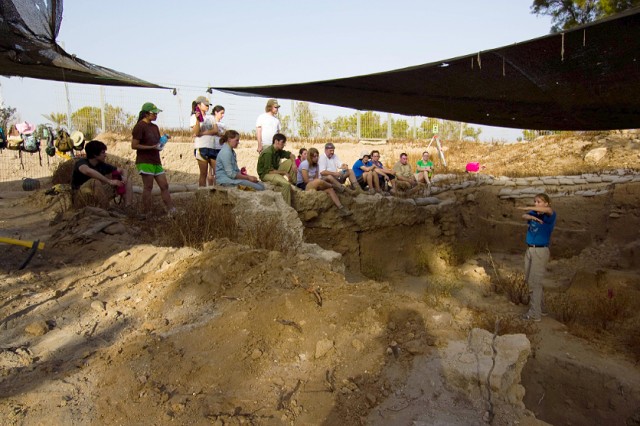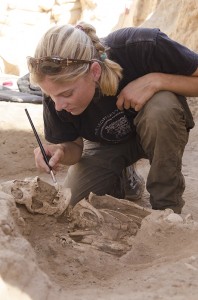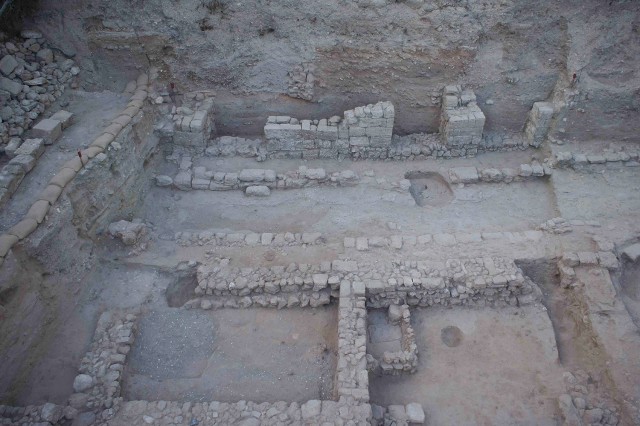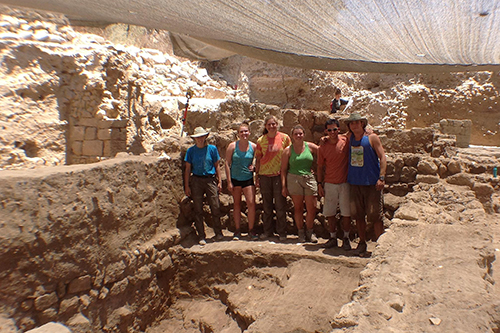Birney’s Fellowships Support Research, Archaeology

Between 2500-1200 B.C., Ashkelon was one of the largest and most important commercial centers around the Mediterranean, and it remained a thriving metropolis under varying degrees of Egyptian control until until the Crusaders conquered the city in the 12th century. Today, the site remains preserved, as does a 3,500-year-old, two-story-high mudbrick-archway.

Since 1985, the site has been excivated by the Leon Levy Expedition — a joint project drawing students and faculty from Wesleyan, Harvard University, Wheaton College and Boston University. To date, Ashkelon archaeological digs have revealed a neighborhood of elite Philistine houses dating from the 11th-10th centuries B.C.
Every year, Kate Birney, assistant professor of classical studies, assistant professor of archaeology, leads a student excavation team at the site of Ashkelon. And as a recipient of two fellowships from the 2014-15 academic year, she will continue her research on the historic area.
Next fall, as a National Endowment for the Humanities fellow, Birney will conduct research at the Albright Institute in Jerusalem; and in the spring, she’ll complete a Fellowship at the Center for Hellenic Studies in Washington, D.C. Both fellowships are related to her present research at Wesleyan.
“Since I specialize in interconnections between ancient Greece and the Near East, I’m particularly excited about these fellowships. The fall NEH will allow me to work within a community of scholars who specialize in Near Eastern archaeology, to process the archaeological data, while the spring fellowship at the CHS will allow me to develop my ideas within a community of Classical scholars,” she said.
In Jerusalem and Washington D.C., Birney will work on her current book project, which focuses on the Hellenistic period (ca. 330 B.C. to ca 100 B.C.) – the time when Alexander the Great and his successors “the Diadochs” controlled the larger Mediterranean. She is studying the degree and nature of Hellenization at the city of Ashkelon as manifest in the archaeological record, in the materials of daily life.
“This (study) allows me to compare public actions (I.e. Coinage, the construction of monumental public buildings) with the private preferences of its citizens (who is dining in the Greek style? Who is worshipping Greek gods?). By creating cultural maps of neighborhoods I can assemble a more nuanced picture of the life of the city and determine the extent to which its citizens embraced or rejected Greek culture, even when the ruling class was promoting it,” she explained.
Birney’s research draws upon a tremendous amount of archaeological data to reconstruct the city’s political, social and economic history. She’s also exploring how communities negotiate their identities under an imperial shadow, to balance political and cultural ideologies.
A series of videos, featuring updates from Wesleyan students on the Ashkelon Archaeological dig, is available online here. For more information on the dig, visit this website.



